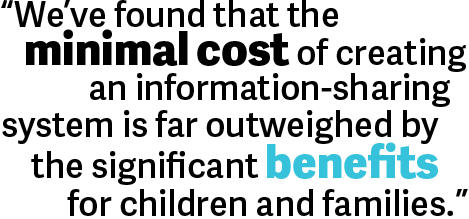Implementing an information-sharing process requires that you provide oversight of and administrative support to the staff engaged in sharing information. Additionally, as new information-sharing processes and protocols are employed, it’s important to monitor how things are going. Are the new systems working as everyone had envisioned, or do some aspects need tweaking? It’s best to introduce refinements early before ineffective procedures become well-established.
The following strategies can help to build and maintain infrastructure to support information sharing—to ensure that it becomes a critical, lasting feature of how your community’s schools and other agencies collaborate to support children and families:
- Broaden your partnership to engage additional sectors in sharing information. Doing so can help to increase both ownership and sustainability. Make sure that leaders from schools and mental health, law enforcement, juvenile justice, and child welfare are actively engaged in the partnership. Remember to create interagency MOUs that incorporate every sector involved. Consider rotating leadership of the partnership at regular intervals to share the workload and enhance engagement. As information-sharing partnerships become more established, some groups find that they are able to bring about significant systems changes that contribute to a wide range of positive outcomes for youth and their families.
- Develop and refine information-sharing policies and protocols, with a special emphasis on cross-systems policies that support information sharing, such as shared databases and uniform consent forms.
- Build staff capacity. Train new staff in information-sharing policies and procedures, and deliver refresher training on a regular basis to staff who have already been trained. Whenever possible, have staff from partnering agencies participate in the same training.
- Communicate to Stakeholders. Let stakeholders, including parents, know that your schools and community agencies are working together to support youth, including sharing information about youth involved in multiple systems to connect them to appropriate supports, reduce duplication of services, and free up resources to serve more children and families. Explain that information is always shared in keeping with federal and state confidentiality laws. Communicating about how your community shares information makes the process more transparent and increases the likelihood that stakeholders will appreciate that it is being carried out in a legal, fair manner. Some school districts include a description of their approach to information sharing in the student handbook and post it on the district’s website.
- Allocate time and funding for information sharing. Make sure that information sharing is written into the job descriptions of professionals who engage in it on a regular basis.
